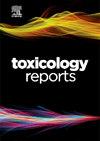伏马菌素B1神经毒性:临床前证据、生化机制和治疗策略
Q1 Environmental Science
引用次数: 0
摘要
真菌毒素对人类和动物的神经毒性作用已被充分记录。伏马菌素B1 (FB1)是一种由镰刀菌属真菌产生的真菌毒素,是毒性最大的伏马菌素变体,其神经毒性作用仍在研究中。本文综述了FB1神经毒性的生化方面,如其作用机制和治疗策略。体外和体内研究都表明鞘脂代谢的改变是fb诱导的神经毒性的主要事件。研究还表明,由FB1引起的神经毒性涉及大脑中几种生化事件的失调,如氧化应激和炎症的诱导、线粒体功能障碍和相关的程序性细胞死亡、乙酰胆碱酯酶的抑制和神经递质水平的改变、Na+K+ atp酶活性的降低以及血脑屏障的破坏。本综述强调了fb1诱导的神经毒性的潜在公共卫生影响,以及限制人类和动物接触fb1以防止其神经毒性作用的必要性。此外,希望本综述能够激发旨在填补当前研究空白的研究,如描述FB1对血脑屏障的影响以及FB1引起的神经毒性的适当治疗。本文章由计算机程序翻译,如有差异,请以英文原文为准。
Fumonisin B1 neurotoxicity: Preclinical evidence, biochemical mechanisms and therapeutic strategies
The neurotoxic effects of fungal toxins in both humans and animals have been well documented. Fumonisin B1 (FB1), a mycotoxin produced by fungi of the Fusarium species, is the most toxic fumonisin variant whose neurotoxic effect is still being elucidated. This review highlights the biochemical aspects of FB1 neurotoxicity, such as its mechanisms of action as well as therapeutic strategies. Both in vitro and in vivo studies have demonstrated that alteration in sphingolipid metabolism is a major event in FB-induced neurotoxicity. Studies have also shown that neurotoxicity due to FB1 involves dysregulation of several biochemical events in the brain, such as induction of oxidative stress and inflammation, mitochondrial dysfunction and associated programmed cell death, inhibition of acetylcholinesterase and alteration of neurotransmitter levels, decreased activity of Na+K+ ATPase, as well as disruption of blood-brain barrier. This review highlights the potential public health effects of FB1-induced neurotoxicity and the need to limit human and animal exposure to FB1in order to prevent its neurotoxic effect. Moreover, it is hoped that this review would stimulate studies aimed at filling the current research gaps such as delineating the effect of FB1 on the blood-brain barrier and appropriate therapies for neurotoxicity caused by FB1.
求助全文
通过发布文献求助,成功后即可免费获取论文全文。
去求助
来源期刊

Toxicology Reports
Environmental Science-Health, Toxicology and Mutagenesis
CiteScore
7.60
自引率
0.00%
发文量
228
审稿时长
11 weeks
 求助内容:
求助内容: 应助结果提醒方式:
应助结果提醒方式:


